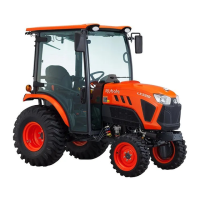(1) Drawbar
• For trailing PTO-driven implements, set the drawbar
to the towing position.
•
Attach pulled or towed loads to the drawbar only.
• Keep all shields and guards in place. Replace any
that are missing or damaged.
• Avoid sudden starts. To avoid upsets, slow down
when turning, on uneven ground, and before
stopping.
• The tractor cannot turn with the differential locked
and attempting to do so could be dangerous.
• Do not operate near ditches, holes, embankments,
or other ground surface features which may
collapse under the tractor's weight. The risk of
tractor upset is even higher when the ground is
loose or wet. Tall grass can hide obstacles; walk the
area first to be sure.
• Watch where you are going at all times. Watch for
and avoid obstacles. Be alert at row ends, near
trees, and other obstructions.
• When working in groups, always let the others
know what you are going to do before you do it.
• Never try to get on or off a moving tractor.
• Always sit in the operator's seat when operating
levers or controls.
• Do not stand between tractor and implement or
trailed vehicle unless the parking brake is applied.
3. Safety for children
Tragedy can occur if the operator is not alert to the
presence
of children. Children generally are attracted to
machines and the work they do.
• Never assume that children will remain where you
last saw them.
• Keep children out of the work area and under the
watchful eye of another responsible adult.
• Be alert and shut your machine down if children
enter the work area.
• Never carry children on your machine. There is no
safe place for them to ride. They may fall off and be
run over or interfere with your control of the
machine.
• Never
allow children to operate the machine even
under adult supervision.
• Never allow children to play on the machine or on
the implement.
• Use extra caution when backing up. Look behind
and down to make sure area is clear before
moving.
4. Avoiding crystalline silica (quartz)
dust
To avoid serious injury or death from silica dust:
• A
void exposure to dust containing crystalline silica
particles.
This dust can cause serious injury to the lungs
(silicosis).
Because crystalline silica is a basic component of
sand and granite, many activities at construction
sites produce dust containing crystalline silica.
Trenching, sawing and boring of material containing
crystalline silica can produce dust containing
crystalline silica.
• If
dust which contains crystalline silica is present,
there are guidelines which should be followed:
– Be aware of the potential health effects of
crystalline silica and that smoking may add to
the damage.
– Be aware of and follow OSHA (or other local,
State or Federal) guidelines for exposure to
airborne crystalline silica.
– Know the work operations where exposure to
crystalline silica may occur.
– Participate in air monitoring or training
programs offered by the employer.
– Be aware of and use optional equipment
controls such as water sprays, local exhaust
ventilation, and enclosed CABs with positive
pressure air conditioning, if the machine has
such equipment. Otherwise respirators shall be
worn.
– Where respirators are required, wear a
respirator approved for protection against
crystalline silica containing dust. Do not alter

